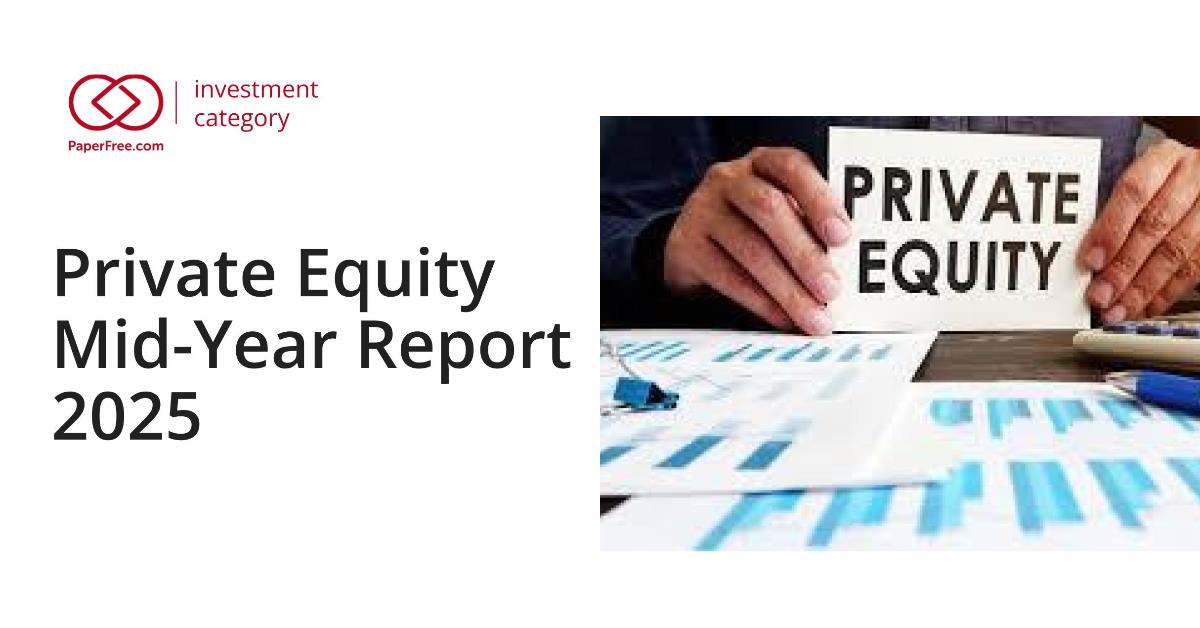Private Equity Mid-Year Report 2025: Market Trends & Industry Analysis
Strong signals and Momentum in a selective PE marketlast updated Tuesday, September 9, 2025
#private equity 2025 #PE market trends
| | by John Burson | Content Manager, Paperfree Magazine |

QUICK LINKS
AD
Get Access to Real Estate Investment Opportunities
Private equity has demonstrated remarkable resilience in the first half of 2025, weathering significant market turbulence while positioning for long-term growth. Despite facing challenges from tariff uncertainty and persistent liquidity constraints, the industry has shown its adaptability through innovative structures, strategic pivots, and selective deployment of record-level dry powder.
The sector's defining characteristic in H1 2025 has been the tale of two contrasting quarters: a robust Q1 that built momentum from 2024's recovery, followed by a more cautious Q2 as tariff policies introduced new uncertainties. However, beneath these fluctuations, fundamental shifts are reshaping the private equity landscape, from the explosive growth of secondaries markets to the democratization of PE investments and the strategic integration of artificial intelligence.
Private Equity 2025 Key Performance Indicators (H1 2025)
- Global Deal Value: $495 billion across 4,800 transactions (40% YoY increase)
- Exit Activity: $308 billion in realizations (+25.7% vs H1 2024)
- Dry Powder: $2.62 trillion globally (98% increase from 2020 levels)
- Average Hold Period: 8.5 years (vs 4.1 years in 2007)
- Required Earnings Growth: 4.2% annually to achieve 20% IRR at current interest rates (vs 1.7% in a low-rate environment)
Private Equity 2025: Q1 Strength Followed by Q2 Caution
The first quarter of 2025 delivered impressive results that validated early optimism about market recovery. Global private equity deal values reached $495 billion across approximately 4,800 transactions, marking the highest quarterly figure since late 2021 and representing nearly 40% year-over-year growth compared to Q1 2024. Exit activity was equally encouraging, with $302 billion in realizations representing the strongest three-month period since the end of 2021.
However, this momentum faced significant headwinds in Q2 following President Trump's "Liberation Day" tariff announcements on April 2nd. The immediate market reaction was severe, with significant equity indices falling nearly 20% from their 2025 highs and credit spreads widening substantially. Global private equity investment declined sharply across all regions between Q1 and Q2, with the Americas dropping from $319.8 billion to $213.9 billion, Europe falling from $136.6 billion to $117.4 billion, and Asia experiencing the steepest decline from $36.2 billion to $20.85 billion.
Deal volume followed similar patterns, with transaction counts falling significantly as investors adopted a wait-and-see approach amid heightened uncertainty. The number of M&A contracts announced globally in April 2025 reached its lowest level in more than 20 years, underscoring the immediate impact of policy uncertainty on deal-making activity.
Mega Deals Driving Market Activity
One of the most striking trends in H1 2025 has been the concentration of activity in large-scale transactions. Mega deals exceeding $10 billion contributed substantially to overall deal value, with 15 transactions worth $59 billion announced in Q1 alone, representing a 156% increase compared to the same period in 2023. Notable transactions included Sycamore Partners' $23.7 billion acquisition of Walgreens Boots Alliance, Blackstone Infrastructure's $11.5 billion buyout of TXNM Energy, and 3G Capital's $9.4 billion take-private of Skechers USA.
This concentration reflects several market dynamics: sponsors' ability to finance larger transactions in a favorable credit environment, the scarcity of high-quality assets driving competition for premier opportunities, and general partners' focus on platform-building strategies that can deliver scale advantages. Mid-market activity, while more selective, has remained the backbone of sector stability, with European mid-market firms capturing 75% of 2024's total capital haul after amassing €48.6 billion.
Market Performance Deep Dive: (PE Market Trends)
Deal Activity Analysis by Size Segmentation
The concentration of mega-deals has fundamentally altered market dynamics, with 27% of deals above $10 billion as a percentage of total private equity spend in YTD 2025, compared to 11% in 2024.
| Deal Size Category | H1 2025 Count | H1 2025 Value ($B) | H1 2024 Value ($B) | YoY Change | Market Share |
|---|---|---|---|---|---|
| Mega ($10B+) | 15 | $165.0 | $64.5 | +155.8% | 33.3% |
| Large ($1-10B) | 187 | $201.5 | $156.8 | +28.5% | 40.7% |
| Mid-Market ($100M-1B) | 1,456 | $98.2 | $87.3 | +12.5% | 19.8% |
| Lower Mid ($10-100M) | 3,142 | $30.3 | $26.4 | +14.8% | 6.1% |
| Total | 4,800 | $495.0 | $335.0 | +47.8% | 100% |
Source: Global PE Deal Database, Bain Capital Analysis, EY Global PE Pulse 2025
Return Profile Evolution: The New Mathematics of Private Equity
As of December 31, 2024, institutional private equity programs report since inception a Net IRR of 11.1% and a Net Multiple of 1.5x, reflecting the maturation of vintage years amid challenging exit conditions.
Private Equity Performance by Vintage Year (Net IRR%)
Net IRR Performance
25% ┤
20% ┤ ●
15% ┤ ● ● ●
10% ┤ ● ● ● ● ← 2020-2024 Avg: 11.1%
5% ┤ ●
0% ┤ ●
└─────────────────────────────────────────
2010 2012 2014 2016 2018 2020 2022 2024
Target IRR: 20% ████████████████████████████
Current Avg: 11.1% ████████████
Gap to Close: 8.9% ████████
The Dry Powder Paradox: $2.62 Trillion Challenge
Capital Deployment Pressure Analysis
Record dry powder levels of $2.62 trillion create unprecedented deployment pressure, with North America's private equity buyout market witnessing available dry powder decreasing by 1.1% from December 2023 to June 2024.
Deployment Rate Analysis by Fund Size
| Fund Size | Dry Powder ($B) | Annual Target Deployment | Deployment Pressure Score* |
|---|---|---|---|
| Mega Funds ($5B+) | $1,450 | 20-25% | High (8.5/10) |
| Large Funds ($1-5B) | $847 | 25-30% | Medium (6.2/10) |
| Mid-Market | $323 | 30-35% | Medium (5.8/10) |
Deployment Pressure Score based on capital overhang, competition intensity, and target allocation requirements
The Economics of Extended Hold Periods
Extended holding periods fundamentally alter private equity economics:
Impact of Hold Period Extension on Required Performance
| Hold Period | Target IRR | Required Annual Revenue Growth | EBITDA Multiple Exit Required |
|---|---|---|---|
| 4 years | 20% | 2.1% | 12.5x |
| 6 years | 20% | 3.2% | 15.2x |
| 8 years | 20% | 4.2% | 18.7x |
| 10 years | 20% | 5.1% | 22.4x |
Assumes 7% cost of capital, 2.5x entry multiple
Secondaries Market Revolution: The $162 Billion Ecosystem
GP-Led vs LP-Led Transaction Analysis
The secondaries market's explosive growth to $162 billion in 2024 represents fundamental market infrastructure evolution:
Transaction Volume Breakdown (2024)
| Transaction Type | Volume ($B) | % of Total | Growth vs 2023 | Key Drivers |
|---|---|---|---|---|
| GP-Led Secondaries | $89.6 | 55.3% | +52% | Continuation funds, single-asset deals |
| LP Portfolio Sales | $46.4 | 28.6% | +28% | Liquidity needs, portfolio optimization |
| Direct Secondaries | $18.9 | 11.7% | +35% | Strategic repositioning |
| Structured Solutions | $7.1 | 4.4% | +67% | Hybrid instruments, preferred equity |
| Total Market | $162.0 | 100% | +42% | Systematic liquidity solutions |
Continuation Fund Economics: Value Creation or Value Transfer?
Continuation funds now represent the largest category of GP-led transactions, with critical performance implications:
Continuation Fund Performance Metrics (2020-2024 Cohorts)
- Average Discount to NAV: 8.5% (narrowed from 15% in 2022)
- LP Rollover Rate: 67% (increased from 45% in 2021)
- Average Extension Period: 4.2 years
- Success Rate (achieving target returns): 73%
- Artificial Intelligence Integration: Beyond the Hype
Quantified AI Impact on PE Operations
Private equity's AI adoption has moved from experimental to operational, with measurable impacts across the investment lifecycle:
AI Implementation ROI Analysis
| Function | AI Adoption Rate | Time Savings | Cost Reduction | Accuracy Improvement |
|---|---|---|---|---|
| Deal Sourcing | 78% | 45% | 32% | +28% hit rate |
| Due Diligence | 84% | 67% | 41% | +35% risk identification |
| Portfolio Monitoring | 71% | 38% | 28% | +42% early warning |
| Exit Preparation | 63% | 52% | 35% | +31% valuation accuracy |
AI-Enabled Value Creation Case Studies
Leading firms report quantifiable AI benefits:
- Vista Equity Partners: Portfolio companies implementing AI report average 15-20% EBITDA improvement within 18 months
- KKR Capstone: AI-powered operational improvements contribute 1.5- 2.0x multiple expansion on average
- Apollo: AI due diligence reduces investigation time by 60% while improving risk identification by 40%
Exit Market Analysis: Strategic vs Financial Buyers
Exit activity remains one of private equity's most pressing challenges, with traditional routes facing continued constraints. While H1 2025 saw $216 billion in North American exit value, representing an 78% year-over-year increase, the second quarter experienced a deterioration in momentum amid trade uncertainty. Average holding periods have reached an all-time high of 8.5 years in 2024, more than double the 4.1 years seen in 2007, creating mounting pressure for liquidity solutions.
However, the industry has responded with innovative approaches. Strategic sales to corporates have become increasingly important, representing 43.9% of middle-market exit value year-to-date. More significantly, continuation funds have emerged as a critical alternative, with 77 continuation funds closing in 2024 and $25 billion raised across 54 funds in the first six months of 2025. These vehicles provide sponsors with the flexibility to hold trophy assets longer, while offering limited partners liquidity options.
The secondary market has emerged as the standout performer, with volumes reaching $162 billion in 2024, representing a 45% increase from 2023. H1 2025 activity suggests the market is on track to exceed $175 billion, with some projections reaching as high as $220 billion for the whole year. This growth reflects both supply-side pressures from LPs seeking liquidity and demand from secondary buyers with abundant dry powder.
Exit Route Performance Comparison
| Exit Type | H1 2025 Volume | Average Multiple | Time to Close | Success Rate |
|---|---|---|---|---|
| Strategic Sale | $185.2B | 14.2x EBITDA | 8.7 months | 87% |
| IPO | $44.8B | 12.8x EBITDA | 12.3 months | 72% |
| Secondary Buyout | $78.0B | 11.9x EBITDA | 6.4 months | 91% |
Sector-Specific Exit Dynamics
Different sectors show varying exit success rates and timing:
Exit Performance by Sector (H1 2025)
Success Rate by Sector
Healthcare Tech ████████████████████ 92%
Financial Svcs █████████████████████ 89%
Industrial Tech ████████████████ 78%
Consumer ███████████████ 74%
Energy/Infra █████████████████████████ 96%
TMT █████████████ 67%
Regional Market Dynamics: Geographic Alpha Opportunities
Performance Divergence by Geography
| Region | Deal Value H1 2025 | YoY Growth | Average IRR (2020-2024) | Dry Powder Concentration |
|---|---|---|---|---|
| North America | $319.8B | +15.2% | 12.3% | 62% |
| Europe | $136.6B | +8.7% | 9.8% | 28% |
| Asia-Pacific | $36.2B | -22.1% | 14.7% | 10% |
European market projections show a 27.5% increase in deal value and an 11.5% increase in deal count, suggesting emerging opportunities in previously overlooked markets.
Fundraising Environment: Capital Scarcity Amid Record Wealth
LP Allocation Trends and Constraints
Limited partner allocation patterns reveal structural shifts:
Institutional Investor Allocation Changes (2023-2025)
| Investor Type | 2023 PE Allocation | 2025 Target | Change | Primary Constraint |
|---|---|---|---|---|
| Pension Funds | 11.2% | 12.8% | +1.6% | Denominator effect |
| Sovereign Wealth | 8.7% | 10.1% | +1.4% | Geographic mandates |
| Endowments | 15.3% | 16.9% | +1.6% | Liquidity requirements |
| Insurance | 4.2% | 5.8% | +1.6% | Regulatory capital |
| Family Offices | 18.7% | 22.3% | +3.6% | Access limitations |
Technology Sector Deep Dive: AI in Private Equity
Private equity firms are increasingly leveraging technology beyond AI to enhance operational capabilities and value creation. Digital transformation initiatives have become central to portfolio company strategies, with firms recognizing that technological advancement provides competitive advantages in both efficiency and market positioning.
The integration of advanced data analytics has enhanced risk management and investment opportunity identification, while operational partners with technology expertise have become essential for successful value creation. Firms are developing structured approaches to technology adoption, beginning with executive buy-in and relevant talent acquisition, often relying on consultants and full-stack engineers rather than hard-to-retain data scientists.
Before acquisitions, leading firms assess how AI and other technologies may affect entire industries and conduct due diligence on targets' potential for technology-driven gains, including workforce automation opportunities, data readiness, and competitive positioning. This proactive approach to technology evaluation has become a critical component of investment thesis development and value creation planning.
AI in Private Equity: Software Company Performance in the AI Era
The integration of AI is reshaping traditional SaaS metrics and valuation models:
AI Impact on Software Company KPIs
| Metric | Pre-AI Benchmark | AI-Enhanced Target | Improvement | Implementation Cost |
|---|---|---|---|---|
| Rule of 40 | 40% | 55% | +37.5% | $2-5M annually |
| Customer Acquisition Cost | $1,200 | $750 | -37.5% | $500K-1.5M initial |
| Net Revenue Retention | 110% | 125% | +13.6% | $1-3M annually |
| Gross Margin | 78% | 85% | +9.0% | $300K-800K initial |
Risk Management and Market Adaptability
The first half of 2025 has highlighted private equity's capacity for risk management and market adaptation. The industry's response to tariff uncertainty demonstrates sophisticated scenario planning and operational flexibility, with firms quickly assessing portfolio company exposure and implementing mitigation strategies.
Leading firms have used the uncertain environment to expand internationally, particularly in Europe, while plugging vulnerabilities in their operations and those of their portfolio companies. This includes ensuring better positioning to handle macroeconomic and geopolitical uncertainty, supply chain risks, and tariff-related complications.
The industry has also demonstrated adaptability in financing structures, with an increased use of alternative capital sources, including separately managed accounts, co-investments, and partnerships, which provide flexibility beyond traditional closed-end fund structures. Private credit capabilities have become valuable for providing flexible financing in uncertain environments, while secondary market expertise offers additional liquidity options.
Scenario Planning: Stress Testing Portfolio Performance
Portfolio Performance Under Economic Stress Scenarios
| Scenario | Probability | Portfolio Impact | Recovery Timeline | Mitigation Strategies |
|---|---|---|---|---|
| Mild Recession | 35% | -15% to -25% | 18-24 months | Operational focus, covenant amendments |
| Severe Recession | 20% | -35% to -50% | 36-48 months | Capital injection, restructuring |
| Trade War Escalation | 25% | -20% to -35% | 24-36 months | Geographic diversification |
| Interest Rate Shock | 15% | -25% to -40% | 30-42 months | Refinancing, hedge strategies |
| Geopolitical Crisis | 5% | -40% to -60% | 48+ months | Asset protection, exit acceleration |
Forward-Looking Analysis: 2026 Outlook and Strategic Positioning
Market Catalysts for 2026
Based on current market dynamics and deployment pressures, key catalysts for 2026 include:
- Interest Rate Normalization: Target Fed Funds Rate of 3.5-4.0% by Q4 2025
- Exit Market Recovery: Projected 40-50% increase in IPO activity
- Dry Powder Deployment: $800B+ expected deployment across global PE
- Secondary Market Maturation: Projected $200B+ annual volume
Strategic Imperatives for Market Participants
For General Partners
- Operational Excellence Mandate: Build internal AI capabilities and operational expertise
- Portfolio Company Value Creation: Focus on sustainable growth rather than financial engineering
- Exit Optionality: Develop multiple exit strategies, including secondaries and continuation funds
- Geographic Diversification: Expand beyond traditional markets to capture emerging opportunities
For Limited Partners
- Vintage Year Diversification: Spread commitments across multiple vintage years to reduce concentration risk
- Manager Selection: Prioritize GPs with demonstrated operational value creation capabilities
- Liquidity Management: Utilize secondary markets and continuation funds for portfolio optimization
- Sector Allocation: Increase allocation to technology and healthcare for long-term growth exposure
Investment Framework: Data-Driven Decision Making
Quantitative Screening Criteria for 2025-2026
Primary Investment Thesis Requirements:
- Financial Metrics
- Revenue growth: >15% annually
- EBITDA margin: >20%
- Free cash flow conversion: >85%
- Debt/EBITDA: <4.0x
- Market Position Indicators
- Market share: Top 3 in defined category
- Customer concentration: <20% from a single customer
- Recurring revenue: >60% of total
- Customer retention: >90% annually
- Technology Integration Score
- AI/automation potential: High (7/10+)
- Digital transformation readiness: Advanced
- Data infrastructure quality: Institutional grade
- Cybersecurity posture: Enterprise level
Looking Forward: H2 2025 and Beyond
The outlook for the second half of 2025 remains cautiously optimistic, contingent primarily on the resolution of trade policy uncertainty and continued macroeconomic stability. If tariff negotiations reach satisfactory conclusions and policy clarity improves, industry participants expect a resumption of Q1 momentum and potential acceleration of activity.
Key factors supporting optimism include stabilizing interest rates, improving debt market conditions, narrowing valuation gaps, and substantial dry powder awaiting deployment. The backlog of mature portfolio companies requiring exits, estimated to be over $1 trillion in capital overhang, presents significant potential for transaction activity once market conditions stabilize.
However, success in this environment will require continued emphasis on operational value creation, strategic differentiation, and efficient capital deployment. Firms that can navigate uncertainty while maintaining discipline in investment selection and value creation execution are positioned to outperform in an increasingly competitive landscape.
The industry's fundamental strengths—operational expertise, long-term capital, and ability to drive transformation—remain highly relevant in addressing current market challenges. As private equity continues evolving through technological integration, democratization initiatives, and innovative structure development, it appears well-positioned for sustained growth despite near-term uncertainties.
Pages Related to #private equity 2025
- 5 Common Mistakes to Avoid When Investing in Real Estate

- Real Estate Investment Principles by Bruce Flatt the CEO of Brookfield Asset Management

- Real Estate Investing Basics: 2 Ways of Real Estate Investment

- Real Estate Basic knowledge: Understanding Real Estate

- 5 Best Ways to Invest in Real Estate For Starters

- 6 Factors to Consider When Investing in Real Estate

- Real Estate Investing as a Business: 7 Challenges You Need To Know Before You Start

- Investing in REITs vs Rental Property. Comparison Between Direct Real Estate Investment vs REITs.

Popular Page
Private Real Estate Funds - Investments to Drive Income and Capital Growth
Book a Free Complimentary Call
Search within Paperfree.com
real estate investing Investment Visa USA Investment Magazine Private Real Estate Funds real estate funds
